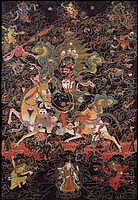
|
Mahakali Makzor Gyalmo (painting no. 516)
|

View Larger Image |
||||||||||||||
|
'Queen of the Weapon Army' (Magzor Gyalmo), with one face and two hands, holding aloft a vajra stick in the right hand and a skullcup in the left, held to the heart. Above the head is a peacock canopy. She rides a donkey; standing in the middle of an ocean of blood with rocky crags and out-croppings. At the top center is the oath bound protector Tashi Tseringma with her four attendants, two on either side. At the bottom on the right and left are two attendants and a central figure [which remains unidentified]. This subject, often commonly ascribed as Shri Devi (who has four hands), is in fact the main attendant to Shri Devi and they are two different deities with different histories and personalities. 'The Queen of the Weapon Army' is the wrathful aspect of the very peaceful goddess Sarasvati (Yang Chenma). Any serious undertaking of the practice of 'The Queen of the Weapon Army' is always done with a self-visualization of some wrathful form of Manjushri. She is always a protector and is also used for divination rituals. Most Tibetan Schools have some form of this deity. It is commonly found on Sakya and Gelugpa paintings. This practice was adopted early on as the special protector for the Dalai Lamas and the Namgyal College of the Tse Potala Palace. The method of painting is called 'nag thang,' gold outline on a black background. Jeff Watt 4-98
|
|||||||||||||||
Photographed Image Copyright © 1998 Shelley & Donald Rubin Foundation
|
|
| |
Next Image |